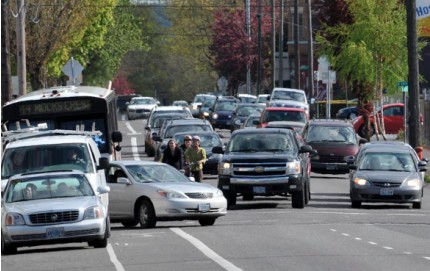
(Photos © J. Maus)
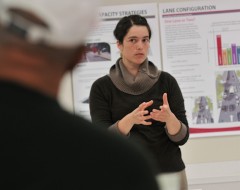
Stakeholder Advisory Committee meeting yesterday.
(Photos © J. Maus)
Several signs, including results from the recent North Williams Traffic Safety Operations project open house, point to growing community support for a cycle track and one motor vehicle lane (from the existing two) the entire length of Williams Avenue — including the dense commercial section between N Cook and Skidmore (a.k.a. Segment 4).
Surprisingly, PBOT’s current proposal is to do nothing to improve bike access in this busy section due to how it might impact motor vehicle capacity and based on fears that concerns of business owners and residents would make the project controversial.
“We definitely don’t want to do something that people will feel like will be bad for small businesses. That’s not going to carry at City Council.”
— Rob Burchfield, City Traffic Engineer
However, after a meeting of the Stakeholders Advisory Committee (SAC) yesterday, PBOT just might change their stance and officially consider having one lane of motor vehicle traffic in Segment 4 — thereby setting the stage for a greatly enhanced bikeway that would run all the way from Weidler to Killingsworth.
While project manager Ellen Vanderslice would not confirm with us that the one-lane option will be on the table (she said the issue is, “still under discussion internally”), many signs point toward growing political feasibility to make it happen.
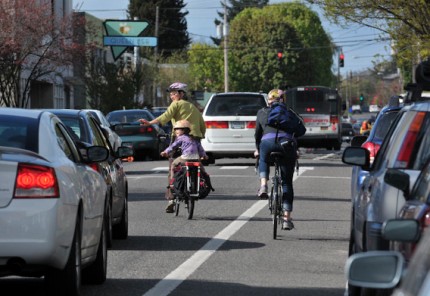
Results from the April 16th open house were made public at the meeting yesterday. Alta Planning and Design (the consultants on the project hired by PBOT) drafted a memo of the feedback received from the 117 people who came to the event and the 24 people who shared comments after viewing a “virtual open house” made available online.
Alta’s memo lists ten “key themes” from the feedback.
One of the key themes was to, “Re-examine the potential to improve bicycling conditions in Segment 4… With an enhanced bikeway.” It was also noted that Segment 4 received the most complaints about parking/loading/unloading in the bike lane, dooring, and “inadequate bike lane capacity.”
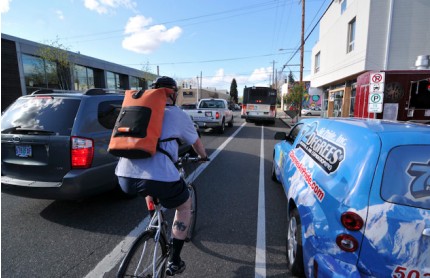
On the other side of the issue, the Alta memo also noted, “a number of business owners (and others)” in Segment 4 that, “were concerned about the possibility of reducing the amount of on-street parking.”
At the stakeholder meeting yesterday, several people spoke up to say they were not in favor of any reduction in auto lanes in Segment 4 (including, surprisingly, the owner of Cha! Cha! Cha! Taqueria); but when a straw poll was conducted, a large majority of committee members (10 out of 13 or so present according to my count) voted in support of putting forward a one-lane option (at this time, parking lane removal isn’t being considered).
Another sign of support for the one-lane option came from an unexpected source: real estate developers. Project consultants and PBOT met with developers who own property on N. Williams to get their take on the issue. SAC member Diana Moosman, who reprsents MOSI Architecture, told the committee that the developers, “Unanimously felt they would advocate for one-lane on Williams all the way.” (She also added they were not in favor of simply adding new traffic signals, which is PBOT’s current solution.)

This issue has also stirred up the advocacy community. Active Right of Way (AROW) has been a strong proponent of the one-lane option for several weeks now and the Bicycle Transportation Alliance (BTA) made their stance on the project clear with a blog post just this morning.
While momentum is clearly on the side of a one-lane Williams Avenue, what the actual bikeway ends up looking like remains to be seen.
At the open house, when people were asked which of the two bikeway options they preferred, a cycle track received 116 out of a total 188 votes compared to just 51 votes for an “enhanced (buffered) bikeway” and just 21 votes for leaving the existing bike lane as is.
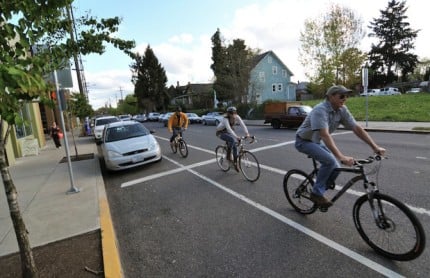
If the committee decides a cycle track is the preferred option, PBOT and Alta have already made it clear that there are many technical issues that could sink the idea. How would a curbside cycle track integrate with TriMet bus stops? Would ADA requirements be a deal-breaker? Could the Fire Bureau still access buildings? How would a cycle track be maintained?
There’s a technical advisory committee currently looking into those issues and is expected to report back soon.
One other hurdle remains for the one-lane/cycle track option.
City Traffic Engineer Rob Burchfield, made it clear at the meeting that businesses hold considerable sway in this process. Here’s how he responded to a question by project consultant Michelle Poyourow about his thoughts on the one-lane option:
“… What we definitely don’t want to do is have businesses upset that we’ve made it more difficult for people to get to their business. We don’t want that perception… if we’re going to go this way [one-lane], it has to be something that works for the local stakeholders, the businesses, and the people that live here… We definitely don’t want to do something that people will feel like will be bad for small businesses. That’s not going to carry at City Council.”
Project staff plans to hold a separate meeting with small business owners in the coming weeks to discuss their concerns.

